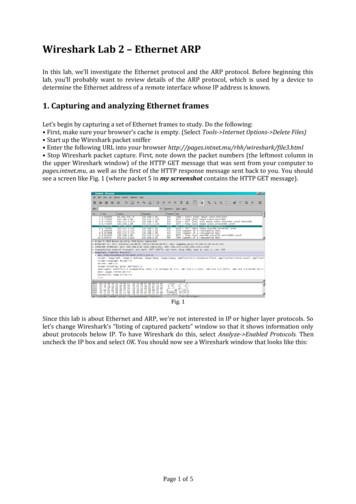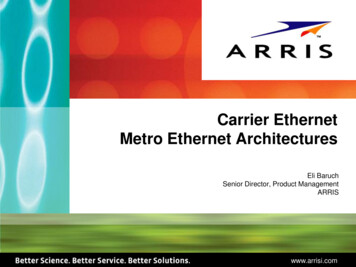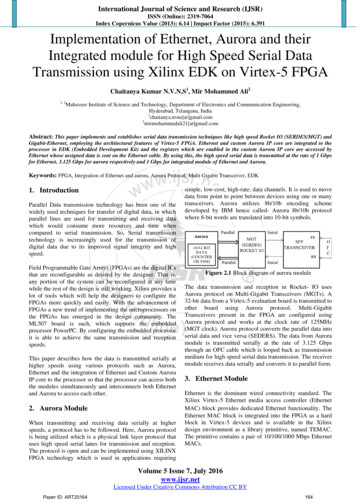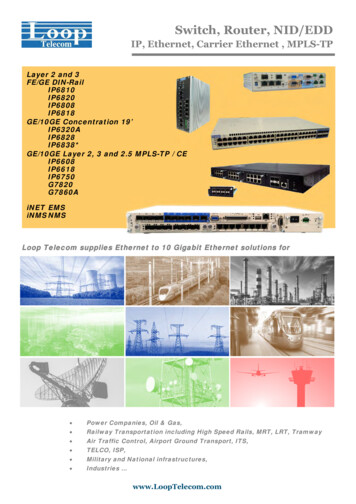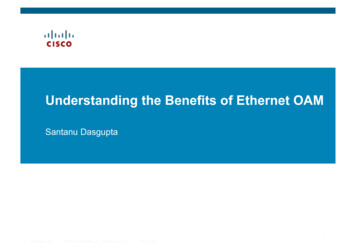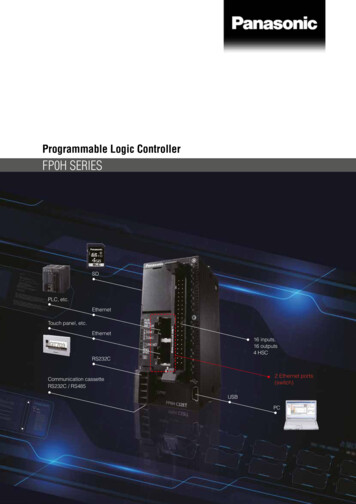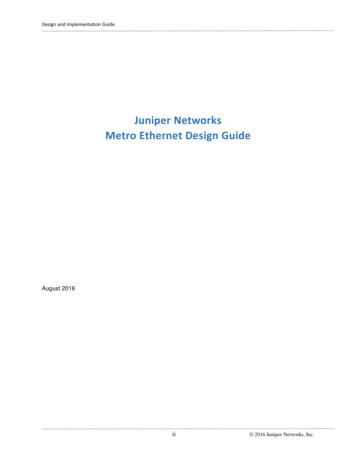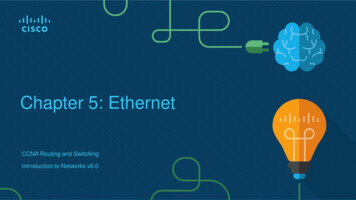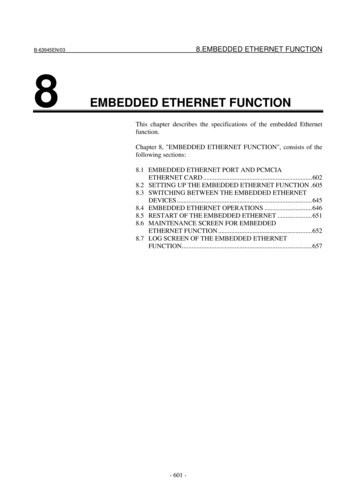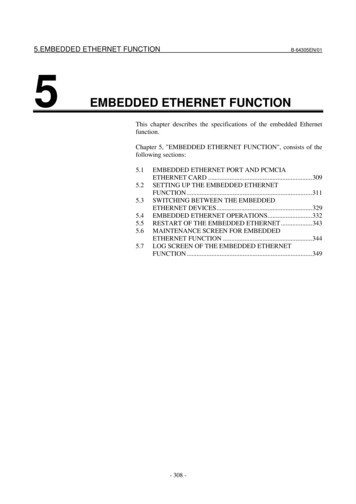
Transcription
Wireshark Lab 2: Ethernet and ARPVersion: 2.0 2007 J.F. Kurose, K.W. Ross. All Rights ReservedIn this lab, we will investigate the Ethernet protocol and the ARP protocol. Before beginning this lab,you should review sections 5.5 (Ethernet), 5.4.1 (link layer addressing) and 5.4.2 (ARP) in the text.RFC 826 (ftp://ftp.rfc-editor.org/innotes/std/std37.txt) contains the gory details of the ARP protocol,which is used by an IP device to determine the link layer address of a remote interface (on the samesubnet) whose IP address is known.1. Capturing and analyzing Ethernet framesBegin by capturing a set of Ethernet frames to study. Do the following: First, make sure your browser’s cache is empty. (To do this under Netscape 7.0, selectEdit- Preferences- Advanced- Cache and clear the memory and disk cache. For InternetExplorer, select Tools- Internet Options- Delete Files. For Firefox select Tools- ClearPrivate Data.Start up the Wireshark packet snifferEnter the following URL into your browser: http://www.uiowa.eduYour browser should display the main University of Iowa web page.Stop Wireshark packet capture.Find the packet numbers (the leftmost column in the upper Wireshark window) of the HTTPGET message that was sent from your computer to gaia.cs.umass.edu, as well as the beginningof the HTTP response message sent to your computer by www.uiowa.edu. You should see ascreen that looks something like this (where frame 48 in the screen shot below contains theHTTP GET message)
Since this lab is about Ethernet and ARP, we are not interested in IP or higher-layer protocols sochange Wireshark’s “listing of captured packets” window so that it shows information only aboutprotocols below IP. To do this, select Analyze- Enabled Protocols. Then uncheck the IP box andselect OK. You should now see a Wireshark window that looks like:
In order to answer the following questions, you will need to look into the packet details and packetcontents windows (the middle and lower display windows in Wireshark).Select the Ethernet frame containing the HTTP GET message. (Recall that the HTTP GET message iscarried inside of a TCP segment, which is carried inside of an IP datagram, which is carried inside ofan Ethernet frame. Expand the Ethernet II information in the packet details window. Note that thecontents of the Ethernet frame (header as well as payload) are displayed in the packet contentswindow.Answer the following questions, based on the contents of the Ethernet frame containing the HTTPGET message. Whenever possible, when answering a question you should hand in a printout of thepacket(s) within the trace that you used to answer the question asked. Annotate the printout to explainyour answer. To print a packet, use File- Print, choose Selected packet only, choose Packet summaryline, and select the minimum amount of packet detail that you need to answer the question.1What is the 48-bit Ethernet address of your computer?
2345What is the 48-bit destination address in the Ethernet frame? Is this the Ethernet address ofwww.uiowa.edu? If not, what device has this as its Ethernet address?Give the hexadecimal value for the two-byte Frame type field. What type of frame does thisspecify?How many bytes from the very start of the Ethernet frame does the ASCII “G” in “GET”appear in the Ethernet frame?What is the hexadecimal value of the CRC field in this Ethernet frame?Next, answer the following questions, based on the contents of the Ethernet framecontaining the first byte of the HTTP response message:6What is the value of the Ethernet source address? Is this the address of www.uiowa.edu? Ifnot, what device has this as its Ethernet address?7 What is the destination address in the Ethernet frame? Is this the Ethernet address of yourcomputer?8 Give the hexadecimal value for the two-byte Frame type field. What type of frame does thisspecify?9 How many bytes from the very start of the Ethernet frame does the ASCII “O” in “OK” (i.e.,the HTTP response code) appear in the Ethernet frame?10 What is the hexadecimal value of the CRC field in this Ethernet frame?2. The Address Resolution ProtocolIn this section, we will observe the ARP protocol in action.ARP CachingRecall that the ARP protocol typically maintains a cache of IP-to-Ethernet address translation pairs onyour computer. The arp command (in both Windows and Linux/Unix) is used to view and manipulatethe contents of this cache. Since the arp command and the ARP protocol have the same name, it isunderstandably easy to confuse them. But keep in mind that they are different - the arp command isused to view and manipulate the ARP cache contents, while the ARP protocol defines the format andmeaning of the messages sent and received, and defines the actions taken on message transmission andreceipt.Take a look at the contents of the ARP cache on your computer: Windows. The arp command is in c:\windows\system32, so type either “arp - a” or“c:\windows\system32\arp -a” in the Windows command line (without quotation marks).Linux/Unix. The executable for the arp command can be in various places. Popular locationsare /sbin/arp (for linux) and /usr/etc/arp (for some Unix variants).The arp –a command will display the contents of the ARP cache on your computer.
11. Write down the contents of your computer’s ARP cache. What is the meaning of eachcolumn value?In order to observe your computer sending and receiving ARP messages, you will need to clear theARP cache, since otherwise your computer is likely to find a needed IP-Ethernet address translationpair in its cache and consequently not need to send out an ARP message. The Windows command “arp–d *” will clear the ARP cache. However, this command requires administrator privileges on thecomputers in the lab. So, instead, simply restart your computer. After restarting the computer, doanother “arp –a” command. You will note that there are already a number of entries in the ARPcache. These are the Ethernet addresses of switches and servers with which your computercommunicated during the start-up processObserving ARP in actionDo the following: Restart your computer to clear the ARP cache, as described above.Start up the Wireshark packet sniffer.From the Windows command line, ping one of the other computers in the lab. (TheWindows computers in 2245 SC have hostnames l-ece000 – l-ece007). Make sure that thecomputer you are attempting to ping is turned on (you do not need to be logged into it.). Sinceall of the computers in 2245 SC are on the same logical subnet, the ping request will generatedirect frame transfers from your computer to the one being pinged. This will require yourcomputer to issue an ARP request to determine the Ethernet address of the computer you arepinging, assuming that the information is not already present in your computer’s ARP cache.Stop Wireshark packet capture. Again, we’re not interested in IP or higher-layer protocols, sochange Wireshark’s “listing of captured packets” window so that it shows information onlyabout protocols below IP. You should now see an Wireshark window that looks like:
In the example above, the Wireshark “arp” filter has been applied to display only ARP packets.Answer the following questions:12 What are the hexadecimal values for the source and destination addresses in the Ethernet framecontaining the ARP request message?13 Give the hexadecimal value for the two-byte Ethernet Frame type field. What type of framedoes this specify?14 Download the ARP specification from ftp://ftp.rfc-editor.org/innotes/std/std37.txt. A readable,detailed discussion of ARP is alsoat pages/arp.html.a. How many bytes from the very beginning of the Ethernet frame does the ARP opcodefield begin?b. What is the value of the opcode field within the ARP-payload part of the Ethernetframe in which an ARP request is made?c. Does the ARP message contain the IP address of the sender?
d. Where in the ARP request does the “question” appear – i.e. the IP address of themachine whose corresponding Ethernet address is being sought?15. Now find the ARP reply that was sent in response to the ARP request.a. How many bytes from the very beginning of the Ethernet frame does the ARP opcodefield begin?b. What is the value of the opcode field within the ARP-payload part of the Ethernetframe in which an ARP response is made?c. Where in the ARP message does the “answer” to the earlier ARP request appear – i.e.the Ethernet address of the machine with the IP address specified in the ARP request?16. What are the hexadecimal values for the source and destination addresses in the Ethernet framecontaining the ARP reply message?17. What is the default amount of time that an entry remains in your ARP cache before beingremoved? You can determine this empirically (by monitoring the cache contents). Indicatehow you determined this value.
Since this lab is about Ethernet and ARP, we are not interested in IP or higher-layer protocols so change Wireshark's "listing of captured packets" window so that it shows information only about protocols below IP. To do this, select Analyze - Enabled Protocols. Then uncheck the IP box and select OK. You should now see a Wireshark window .

